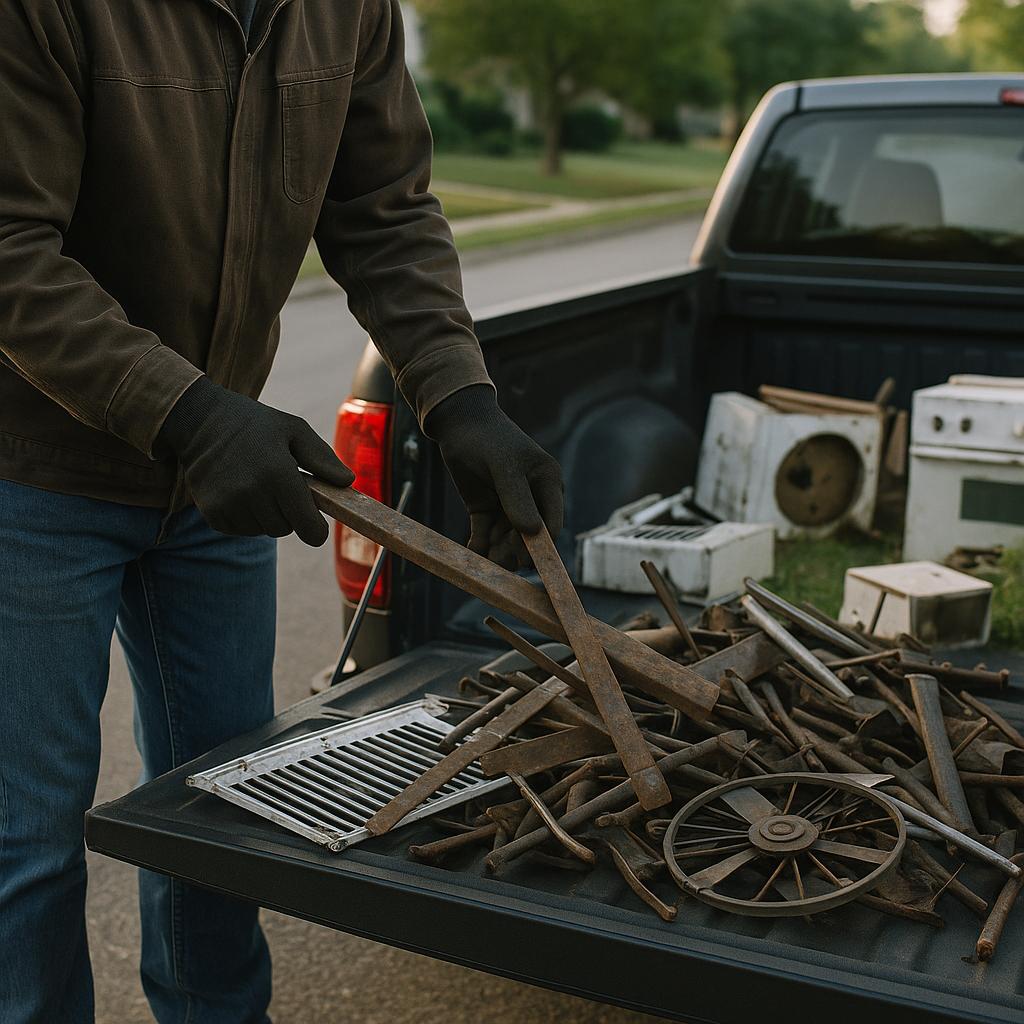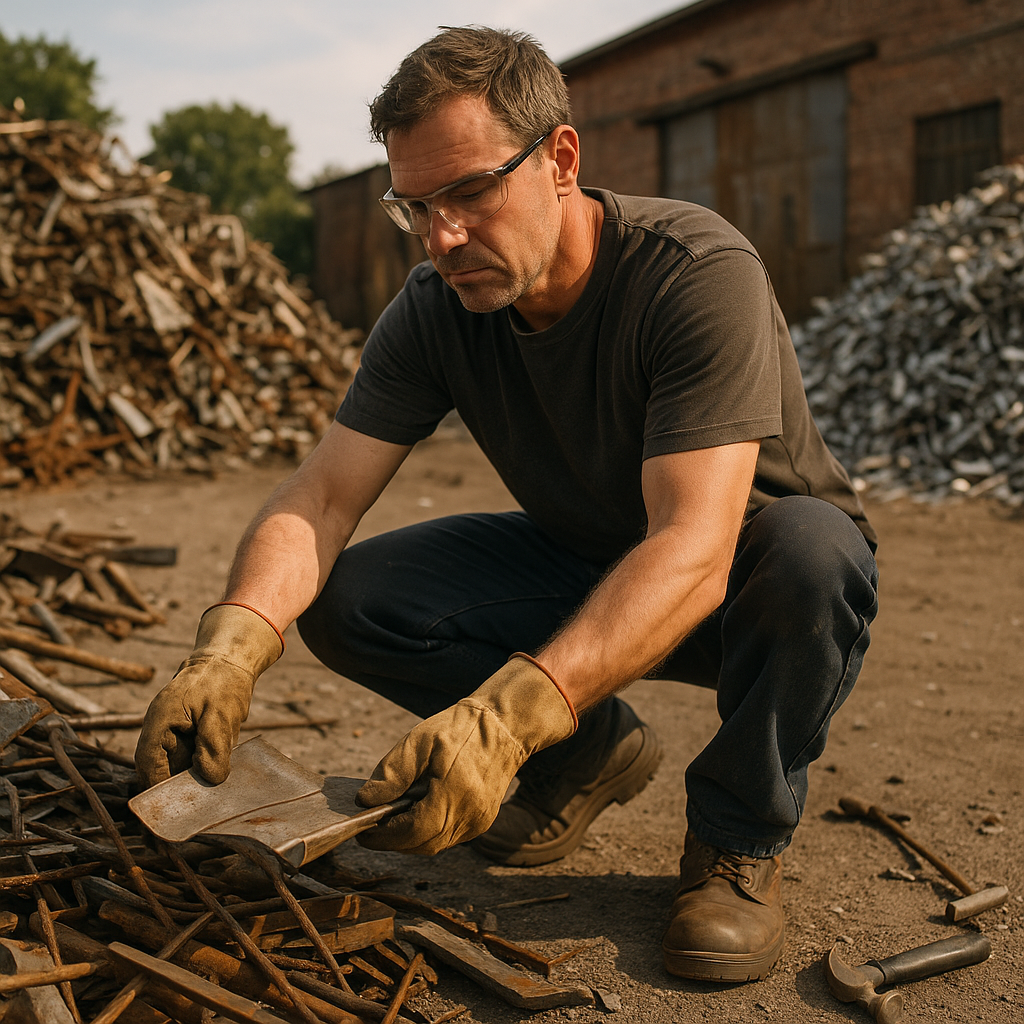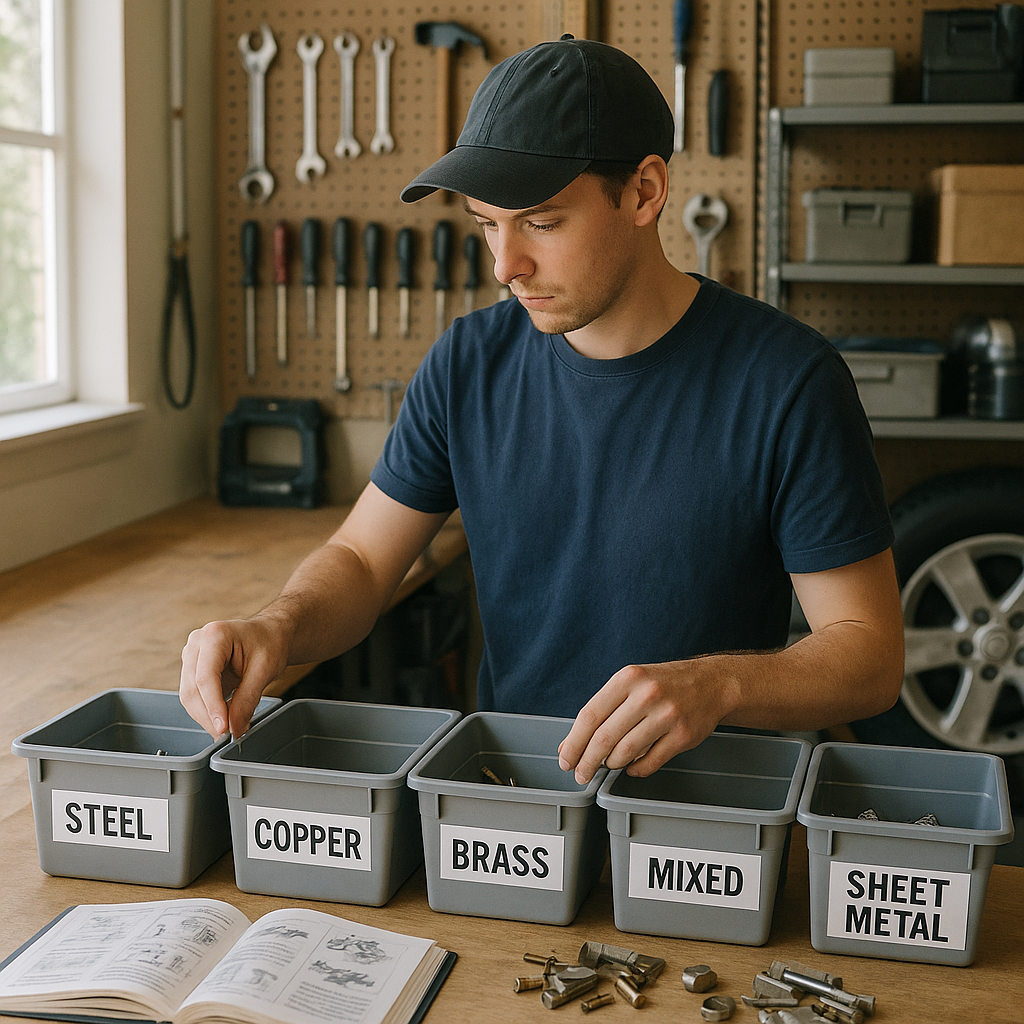5901 Botham Jean Blvd, Dallas, TX 75215
Metal Collecting: How to Identify, Find, and Profit from Scrap Metal Recycling
September 17, 2025Each year, millions of tons of valuable metal that could be recycled end up in landfills. Metal collecting transforms this waste into profit while helping conserve our planet’s finite resources. This practice has evolved from a casual hobby to a sophisticated industry that supports global manufacturing.
Metal collecting involves gathering and sorting discarded metal items for recycling or profit. It encompasses both ferrous metals like steel and iron, as well as non-ferrous metals such as copper, aluminum, and brass. These materials retain their properties no matter how many times they’re recycled, making them perpetually valuable resources.
Collectors search for scrap metal in various locations, including households, construction sites, and junkyards. With a simple magnet test to distinguish between ferrous and non-ferrous metals, even beginners can identify valuable materials. Non-ferrous metals like copper command premium prices at recycling centers, while ferrous metals contribute to the 70% of U.S. steel produced from recycled sources.
How Do You Identify Different Types of Scrap Metal?
Identifying different types of scrap metal is essential for effective recycling and maximizing the value of your materials. The ability to distinguish between metal types can significantly impact the payout you receive at recycling centers. With a few simple tests and visual inspections, you can become proficient at sorting various metals.
The Magnet Test: A Simple but Powerful Tool
The magnet test is a quick and reliable method to determine whether a metal is ferrous or non-ferrous. This fundamental distinction is the first step in proper metal identification.
Here’s how to perform the magnet test:
- Find a medium-sized magnet (refrigerator magnets work well)
- Hold the magnet near or against the metal piece
- Observe whether the metal is attracted to the magnet
- If the magnet sticks, you have a ferrous metal (containing iron)
- If the magnet doesn’t stick, you have a non-ferrous metal (without iron content)
Ferrous metals typically include steel and cast iron, while non-ferrous metals include aluminum, copper, brass, and zinc. Non-ferrous metals generally command higher prices at recycling centers due to their unique properties and applications.
Visual Identification Techniques
After performing the magnet test, visual cues can help you identify specific metal types:
- Copper: Distinctive reddish-brown color; may develop greenish patina when oxidized.
- Brass: Yellowish or golden color; heavier than aluminum but lighter than copper.
- Aluminum: Light silvery-white color; lightweight and doesn’t rust.
- Stainless Steel: Silvery with a polished, reflective surface; typically non-magnetic or slightly magnetic.
- Cast Iron: Dark gray; very heavy and brittle.
- Lead: Dull gray color; extremely heavy for its size.
Weight and Hardness Assessment
The weight of metal can provide valuable clues about its composition. Lead is noticeably heavier than other metals, while aluminum is remarkably lightweight. When comparing two similar-looking metals, the heavier one is often more valuable.
Metal hardness also varies significantly. Copper is relatively soft and can be easily scratched, while steel is much harder. This property can help differentiate between metals that may look similar but have different compositions.
| Metal | Color | Appearance |
|---|---|---|
| Copper | Reddish-brown | May develop a greenish patina when oxidized |
| Brass | Yellowish or golden | Heavier than aluminum but lighter than copper |
| Aluminum | Silvery-white | Lightweight and doesn’t rust |
| Stainless Steel | Silvery | Polished, reflective surface; typically non-magnetic or slightly magnetic |
| Cast Iron | Dark gray | Very heavy and brittle |
| Lead | Dull gray | Extremely heavy for its size |
Oxidation Patterns
How metals react with oxygen can reveal their identity. Iron forms distinctive red rust when exposed to moisture and air. Copper and bronze develop a greenish patina. Stainless steel and chromium show strong resistance to oxidation and maintain their appearance over time.
Understanding these basic identification methods allows for more efficient sorting and helps ensure you receive fair compensation for your scrap. Properly separated metals are easier for recycling facilities to process, creating a more streamlined recycling chain that benefits everyone involved.
Where Can You Find Scrap Metal to Collect?

Scrap metal is often closer than you think, with many potential sources in your own home. Old appliances, such as refrigerators, washing machines, and microwaves, contain valuable materials, including steel, aluminum, and sometimes copper. Non-functioning electronics, like computers, printers, and televisions, have precious metals in their circuit boards and components.
Plumbing fixtures offer another rich source of recyclable metals. Outdated faucets, pipes, and water heaters often include copper, brass, and steel. Even smaller bathroom fixtures collected over time can yield worthwhile scrap. Don’t overlook kitchen items like worn-out pots, pans, and utensils, typically made of aluminum or stainless steel.
Construction and demolition sites generate substantial metal waste. Steel beams, rebar, copper wiring, aluminum siding, and metal studs are commonly discarded during building projects. According to the Construction Materials Recycling Association, construction and demolition waste accounts for the largest sources of trash in the United States, producing approximately 325 million tons of recoverable materials annually. Many contractors appreciate responsible removal of metal waste, as it reduces disposal costs.
Beyond these obvious sources, consider these unexpected places to find scrap metal:
- Abandoned barns and agricultural buildings often contain metal equipment, fencing, and structural components
- Old bicycles and exercise equipment provide steel and aluminum frames
- Lawnmowers, snow blowers, and other seasonal equipment have valuable engine parts
- Metal shelving units, filing cabinets, and office furniture from business closures
- Automotive repair shops regularly discard catalytic converters, brake parts, and other metal components
- Roofing contractors remove metal flashing, gutters, and sometimes copper materials
Building community relationships can provide steady streams of recyclable materials. Neighborhood clean-up events often reveal metal items that residents no longer want. Partnerships with local businesses like restaurants (commercial kitchen equipment), offices (electronics), and retail stores (display fixtures) offer regular access to discarded metal items.
Hardware stores and home improvement centers may have damaged merchandise or display models they need to dispose of. Building relationships with these businesses can give you early access to these items before they enter the waste stream. Similarly, appliance dealers frequently remove old units when delivering new ones, and developing connections with delivery personnel can offer consistent sources.
When sourcing scrap metal, always obtain proper permission and refrain from removing materials from private property without explicit consent. Construction sites, in particular, have strict rules about material removal, and taking items without permission is theft. Ethical collection practices ensure the sustainability of your recycling efforts and help build positive community relationships.
| Household Item | Location | Valuable Metal Content |
|---|---|---|
| Washing Machines and Dryers | Laundry Room | Steel, Copper, Aluminium |
| Refrigerators | Kitchen | Copper, Aluminium, Steel |
| Microwaves | Kitchen | Gold, Silver, Copper |
| Toasters | Kitchen | Nichrome, Aluminium |
| Televisions and Computers | Living Room, Office | Gold, Silver, Copper |
| Lawnmowers | Garden | Metals (various) |
| Plumbing Fixtures | Bathroom, Kitchen | Copper, Brass |
What Safety Precautions Should Metal Collectors Take?

Safety is the cornerstone of successful scrap metal collection. Handling metal scraps exposes collectors to hazards that can cause serious injuries if proper precautions aren’t taken. Sharp edges, heavy materials, and potential contaminants make protective measures essential for anyone involved in scrap metal handling.
Essential Protective Gear
Personal protective equipment (PPE) is your first line of defense against scrap metal hazards. Heavy-duty gloves protect your hands from cuts, punctures, and possible chemical exposure. Safety glasses shield your eyes from flying debris, which is common when sorting or cutting metal.
Steel-toed boots offer critical protection against heavy objects that might fall during handling. A hard hat is necessary in environments where overhead materials or falling objects pose risks. Long sleeves and sturdy clothing protect your skin from scrapes and exposure to harmful substances that may be present on the metal.
For collectors working with potentially contaminated materials, respirators are needed to prevent inhalation of harmful dust or fumes. This is especially important when handling metals with unknown coatings or treatments that could release toxic substances.
Safe Handling Techniques
Proper lifting techniques prevent back injuries and strains when handling heavy metal pieces. Bend at the knees, keep your back straight, and avoid twisting while carrying loads. For particularly heavy items, use tools like hand trucks, dollies, or mechanical lifting equipment.
Keep your workspace clean and organized to prevent trips and falls. Regularly clear away metal shavings and debris to avoid slips. Use brushes or brooms to clean up metal fragments instead of your hands, even while wearing gloves.
When cutting or processing scrap metal, ensure tools are in good condition and use them according to manufacturer instructions. Inspect equipment regularly for wear and tear, and never use damaged tools.
Hazardous Materials Awareness
Some scrap metals may contain or be contaminated with hazardous substances. Old electronics can contain lead, mercury, and other toxic materials. Painted metals might have lead-based paint, especially in older items made before regulations restricted its use.
Be cautious with unknown substances and avoid direct contact. If you suspect contamination, take protective measures and follow local regulations for safe disposal. This knowledge not only protects you but also ensures environmentally responsible recycling practices.
Legal Considerations
Understand local regulations regarding scrap collection. Many areas require permits or licenses for collecting certain types of scrap metal. Some jurisdictions have waiting periods and identification requirements for selling certain metals to combat theft.
Keep records of where you obtained your scrap metal, especially for larger quantities. This documentation can protect you if questions arise about the origin of the materials. Never collect metal from private property without explicit permission to avoid trespassing charges.
| Item | Purpose |
| Gloves | Protect hands from sharp edges and contaminants |
| Safety Glasses | Shield eyes from flying debris |
| Steel-Toed Boots | Provide foot protection against heavy objects |
| Hard Hat | Protect from head injuries in environments with overhead risks |
| Respirators | Prevent inhalation of harmful dust or fumes |
| Long Sleeves and Sturdy Clothing | Protect skin from scrapes and exposure to harmful substances |
| Saw or Cutting Tools | Efficiently cut and break down materials; ensure training and safe usage |
| First-Aid Kit | Handle minor injuries quickly; should be well-stocked |
Understanding transportation regulations is crucial. Overloading vehicles creates dangerous driving conditions and may violate local laws. Secure loads properly with straps, chains, or other devices that meet safety standards. Regularly check these restraints during transport to ensure they remain tight and effective.
How Can You Get Started with Metal Collecting?

Starting with metal collecting is easier than you might think. With basic tools and knowledge, you can turn discarded metal items into cash while aiding environmental sustainability. Here’s how to begin your metal collecting journey.
Essential Tools for Beginners
You don’t need expensive equipment to collect scrap metal. A few basics will set you up for success. First, get a strong magnet—preferably a neodymium one—to distinguish between ferrous and non-ferrous metals. This tool helps identify more valuable metals.
Safety gear is vital. Invest in cut-resistant gloves to protect your hands, safety glasses to shield your eyes, and sturdy closed-toe shoes for heavier items. Long sleeves and pants add extra protection against scratches and cuts.
Dedicated sorting containers simplify organization. Use separate bins, buckets, or even cardboard boxes for different metal types. Properly sorted metals can fetch higher prices at scrap yards. Basic hand tools like screwdrivers, pliers, and wire cutters are useful for disassembling items with mixed materials.
Finding Metal in Your Home
Your initial scrap metal hunt should start at home. Many households have items with recyclable metals. Check your garage, basement, and storage areas for unused or broken items. Old appliances, cookware, plumbing fixtures, and electronics often contain valuable metals ready to be recycled.
Kitchen items like old pots and pans, aluminum cans, and broken utensils are excellent starter materials. Outdated electronics have various metals, from aluminum casings to copper wiring. Broken tools, unused bicycles, and plumbing supplies are also good sources of recyclable metal.
After searching your home, ask family and friends if they have unwanted metal items. Many are happy to have someone haul away their “junk” for free, not realizing its potential value.
Researching Local Scrap Yards
Finding the right places to sell your metal is crucial for maximizing profits. Start by searching online for scrap yards in your area. Websites like iScrap App list recycling centers along with price estimates for different metals. Your state government website might also have directories of licensed recycling facilities.
Call several yards to compare their current buying rates. Prices can vary by 10-20% between facilities for identical materials. Ask about their acceptance policies, minimum quantities, and if they require identification for selling scrap. Some yards specialize in certain metals, so finding one focused on the types you collect can lead to better prices.
Consider practical factors like location, operating hours, and whether they offer unloading assistance. Building relationships with yard operators can provide valuable insights about price trends and sometimes preferential treatment as a regular customer.
Understanding Metal Prices
Metal prices fluctuate regularly based on global market conditions. Staying informed about current rates helps you determine the best time to sell your materials. Several online resources provide up-to-date pricing information, including recycling industry websites and scrap yard social media pages.
Non-ferrous metals like copper, aluminum, and brass typically command higher prices than ferrous metals like steel and iron. Within each category, cleaner, higher-grade materials fetch premium prices. For example, bare bright copper wire (clean, uncoated) is worth significantly more than copper with insulation or contamination.
Remember that quantity matters. Some yards offer better rates for larger amounts of metal. Consider accumulating a reasonable quantity before making a trip to maximize your profit relative to transportation costs.
Starting Small and Building Up
Begin your metal collecting journey with modest goals. Your first collection might be entirely from items at home, offering a low-risk way to learn the basics. Use this opportunity to practice identifying different metals, sorting them, and understanding their values.
With each scrap yard visit, ask questions and observe how materials are processed. Take notes about current prices and how they compare to your research. This knowledge builds your expertise for future collecting efforts.
As you gain confidence, gradually expand your collection sources. Consider checking construction site dumpsters (with permission), asking local businesses about their scrap, or monitoring curbside discards on trash day. Patience and consistency are key—successful metal collecting is a skill developed over time.
Getting Started Checklist
- Purchase a strong magnet, protective gloves, and safety glasses
- Set up labeled containers for different metal types
- Gather basic tools for disassembling items
- Collect metal items from your home and sort them
- Research local scrap yards and their current prices
- Make your first trip with properly sorted materials
- Track what you learn from each experience
- Gradually expand your collection sources
By starting small and learning through experience, you’ll develop the knowledge and skills to make metal collecting both environmentally beneficial and financially rewarding. Almost anyone can start with minimal investment and grow as they go.
Conclusion: Embracing Metal Collecting for Profit and Sustainability

Metal collecting combines personal profit with environmental responsibility. In this article, we’ve examined how this activity offers dual benefits: financial rewards from selling valuable metals and environmental gains through resource conservation. Recycling metals uses significantly less energy than extracting new materials—up to 80% less for most metals and 95% for aluminum. This leads to considerable reductions in greenhouse gas emissions and conserves our planet’s finite resources.
Whether you’re collecting aluminum cans, copper wiring, or larger appliances, your efforts significantly impact the circular economy. For those ready to start their metal collecting journey or to expand their recycling efforts, contact Okon Recycling at 214-717-4083. Our team can help you maximize both the environmental and financial benefits of your metal recycling activities.
